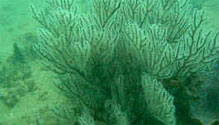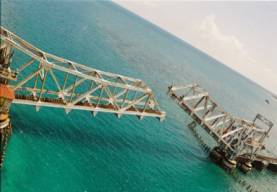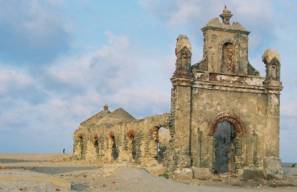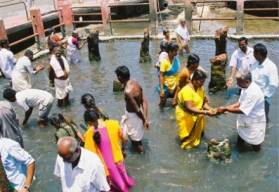GOM BR is located in the southeastern tip of Tamil Nadu extending from
Rameswaram in the North to Kanyakumari in the south. It is the first marine
biosphere reserve (BR) in India. Spreading over an area of 623 hectares
(10,500 km²), the area described as the Pamban-to-Tuticorin barrier
reef was declared a National Park in 1986 and later converted into a Biosphere
Reserve in 1989. The Gulf of Mannar Marine National Park (GOM MNP) comprises
of 21 islands surrounded by coral reef areas along with shallow water
habitat of unique marine biodiversity. Sea horse, Sea Cow, Dolphins, sea
cucumbers etc. are seen here. As all the 21 islands come under the Marine
National Park sphere, tourism and other related activities are NOT allowed.
The park which runs along the coasts of Ramanathapuram
and Tuthukudi (Tuticorin) districts near Mandapam, 150 kms away from Madurai
area, is a part of the Indian Ocean and lies between India and the west
coast of Sri Lanka at a width between 160 and 200 km.
A chain of low islands and reefs known as Rama's Bridge
(based on the epic Ramayana), also called Adam's Bridge, separates the
Gulf of Mannar from the Palk Strait, which lies to the north between India
and Sri Lanka. Tambaraparani River from the coast of India and the Aruvi
Aru from the coast of Sri Lanka merges with the Indian Ocean on both sides
of the park.
 Of the 21 islands, seven islands belong to Mandapam group, seven islands
to Keelakarai group, three islands to Vembar group and four remaining
islands to Tuticorin group. The Marine National Park, one of the richest
coastal regions in Asia, contains over 3,600 species of flora and fauna
most of which are in their virgin form. There are beaches, estuaries and
tropical dry broadleaf forests in the park, and three distinct marine
ecosystems such as sea grass, coral reefs and mangroves along with algal
communities and salt marshes. Around 11 species of sea grass, totally
recorded in India, and nearly 117 species of Hard coral are found
in the Gulf of Mannar. The Kurusadai Islands, off Mandapam boasts of a
vast expanse of shallow waters. The reef is home to sprats, herrings,
barracuda, sea horses, dolphins, Balano-glossus, sea cucumbers, pearl
oysters and turtles. The sandy shores of the islands provide a nesting
habitat for about 5 species of marine turtles. Migratory birds also visit
these islands. But due to destructive fishing and pollution, coral reefs,
dolphins, Dugongs (Dugong Dugon), whales and sea cucumbers are among the
species which figure in the endangered list.
Of the 21 islands, seven islands belong to Mandapam group, seven islands
to Keelakarai group, three islands to Vembar group and four remaining
islands to Tuticorin group. The Marine National Park, one of the richest
coastal regions in Asia, contains over 3,600 species of flora and fauna
most of which are in their virgin form. There are beaches, estuaries and
tropical dry broadleaf forests in the park, and three distinct marine
ecosystems such as sea grass, coral reefs and mangroves along with algal
communities and salt marshes. Around 11 species of sea grass, totally
recorded in India, and nearly 117 species of Hard coral are found
in the Gulf of Mannar. The Kurusadai Islands, off Mandapam boasts of a
vast expanse of shallow waters. The reef is home to sprats, herrings,
barracuda, sea horses, dolphins, Balano-glossus, sea cucumbers, pearl
oysters and turtles. The sandy shores of the islands provide a nesting
habitat for about 5 species of marine turtles. Migratory birds also visit
these islands. But due to destructive fishing and pollution, coral reefs,
dolphins, Dugongs (Dugong Dugon), whales and sea cucumbers are among the
species which figure in the endangered list.
Nearest Attractions
 Pamban
Rail Scissors Bridge, Devipatnam Pamban
Rail Scissors Bridge, Devipatnam
The island of Rameswaram is connected to the
mainland by a 2.06KM long Pamban bridge, which was built in the year 1930
on 145 stone pillars. This bridge can be opened like a pair of scissors
when large vessels need to cross through the strait. A part of this bridge
got damaged during the 1964 cyclone which was rebuilt exactly in the same
manner.
Rameswaram Temple
Rameswaram is an island situated on the northeastern side of
the Gulf of Mannar. It is believed that pilgrimage to Kasi will be finished
only after worshipping at Rameswaram temple.
 Dhanushkodi Dhanushkodi
It has a vast stretch of sandy shores, which forms a marsh in
the middle of the northern side of the island. This marsh gets a little
water from the inundation during the spring tides and supports nearly
6 species of migratory birds which comes from Europe and Australia during
October to January every year. Ruins of the church and other government
buildings constructed during British reign are present here.
Kodandaraman Temple
It is situated on the way to Danushkodi from Rameswaram at a
distance of 30KM from Rameswaram. This is a temple built at the place
where Vibhishana, Ravanasura s younger brother was believed to surrender
himself to Lord Rama and eventually got enthroned by Lakshmana.
 Devipatnam Devipatnam
A coastal village is also known as Navashabashanam. It is believed
that Lord Rama worshipped Navagraha (Nine planets) here. The temple
near by here is dedicated to Devi, who is said to have killed the demon
Mahishasura at this spot. Hindus perform religious rites for their ancestors
here.
Sethukkarai
A place of Puranic importance, Sethukkarai (meaning the Sethu
Coast) is an important pilgrim centre having religious significance owing
to the belief that Lord Ram is said to have constructed a bridge from
here over the sea waters to reach Sri Lanka
|

